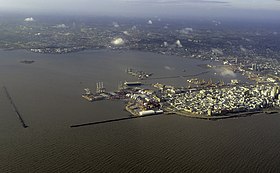Port_of_Montevideo
Port of Montevideo
Port in Uruguay
The Port of Montevideo (Spanish: Puerto de Montevideo), in the northern part of the Old City of Montevideo, Uruguay, is one of the major ports of South America and plays a very important role in the economy of Uruguay.[1][2] Notably the port includes a number of important facilities including one the countries main tourism terminals and the La Teja Refinery which processes the bulk of the countries oil.
This article includes a list of general references, but it lacks sufficient corresponding inline citations. (January 2022) |

